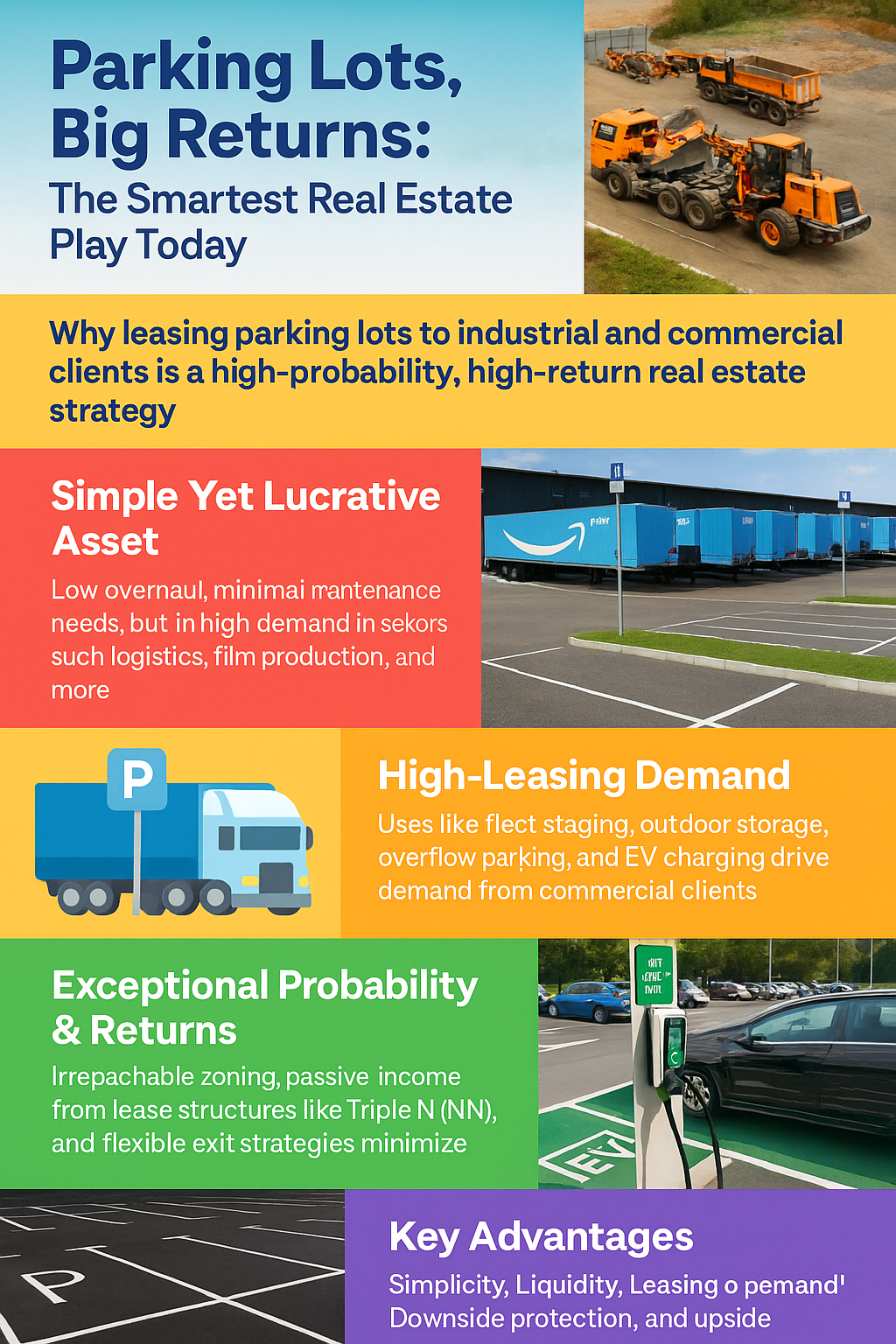Parking Lots, Big Returns: The Smartest Real Estate Play Today

In the vast and complex universe of real estate investing, most institutional and individual investors chase returns in high-rise apartments, luxury condos, or sprawling commercial developments. However, a more overlooked—and arguably superior—strategy lies in acquiring and leasing parking lots to industrial and commercial tenants. On the surface, this may appear simplistic, even uninspiring, but underneath is a uniquely elegant investment model that blends low overhead, high demand, minimal risk, and scalable upside. A well-structured fund that targets these assets can offer one of the highest-probability, highest-return profiles in modern real estate investment.

I. The Case for Parking Lots: A “Dumb” Asset with Smart Upside
Unlike traditional real estate assets that require intensive management—e.g., HVAC systems, elevators, tenant improvements, or costly renovations—parking lots are materially simple. They require little more than grading, striping, lighting, fencing, and occasional asphalt resealing. Yet, they sit at the epicenter of supply-demand imbalances across logistics, last-mile delivery, film production, fleet management, and even the AI and EV revolution. When acquired in the right zoning overlays, they become industrial gold.
The simplicity of the asset is precisely what makes it powerful. It has few moving parts, limited exposure to construction cost inflation, and is quick to deploy into the leasing market. Moreover, it sidesteps many of the permitting challenges and political entanglements facing ground-up developments. In a world where the path of development is filled with uncertainty, parking lots offer clarity and speed.
II. Leasing to Industrial and Commercial Clients: Demand Beyond Parking
The most compelling aspect of this strategy is not simply owning pavement; it’s understanding how valuable controlled land is to high-throughput operators. Today’s industrial and commercial clients don’t just “park”—they operate. Use cases include:
- Fleet staging for Amazon, UPS, FedEx, and regional last-mile players
- Outdoor storage of shipping containers or construction equipment
- Film production basecamps for trucks, trailers, and temporary facilities
- Overflow lots for event venues, sports teams, or convention centers
- EV charging fleet infrastructure
- Laydown yards for modular construction staging or telecom equipment
These users don’t need buildings—they need access, location, and optionality. For many, the ability to stage materials or rotate vehicles on short- to mid-term leases is worth a premium. That gives the parking lot landlord outsized negotiating power.

III. Why This Strategy Offers High Probability and High Return
Most real estate strategies force investors to choose between risk and reward. High-end multifamily offers stability but compressed cap rates. Value-add office or retail? High risk, with uncertain occupancy. But industrially zoned parking lots leased to commercial tenants present an almost paradoxical scenario: high yields with low operational risk.
1. Irreplaceable Zoning and Scarcity
The secret weapon behind this asset class is zoning. Industrial-zoned land near cities—especially coastal markets—is vanishingly rare. Environmental, political, and community opposition make it nearly impossible to entitle new lots. Once a parcel is locked in with the right designation (M1, M2, etc.), it becomes a defensible moat. Meanwhile, demand for logistics, outdoor storage, and fleet infrastructure continues to grow.
2. Triple-Net (NNN) Style Leasing
Many parking lot leases can be structured with minimal landlord obligations. Clients often handle trash, security, power, and even fencing or lot maintenance themselves. This makes the recurring income both predictable and passive, allowing a fund to scale aggressively without ballooning operating costs.
3. Flexibility in Exit and Use
Lots can be repositioned, upzoned, or developed down the road. A parcel used for truck parking today may become an EV fleet charging depot tomorrow—or be sold as a covered land play for data centers, vertical development, or mixed-use conversion. This flexibility creates downside protection while preserving optionality.
4. Fast Stabilization and Cash Flow
Unlike vertical developments that can take 2–3 years to permit and build, a well-located parking lot can be bought, cleaned up, and leased within weeks. The capital can start returning quickly, improving internal rates of return (IRR) and velocity of deployment—two key drivers of fund-level performance.
IV. The Math Behind the Model
Let’s break it down with a hypothetical:
- Purchase Price: $3 million for 1.5 acres of industrial-zoned land in a secondary urban market
- CapEx: $100,000 for grading, fencing, striping, lighting
- Monthly Lease Revenue: $20,000 from a 5-year NNN lease with a logistics fleet operator
- Annual Revenue: $240,000
- Net Operating Income (NOI): $230,000 (after taxes and minor maintenance)
- Return on Cost: 7.6% in Year 1
- Exit Valuation at 5.5% Cap Rate: $4.18 million
- Equity Multiple in 3 Years (with 65% leverage): ~2.5x
These returns eclipse typical stabilized multifamily or retail investments, which often yield 4–6% cap rates and require extensive tenant-facing costs. And unlike ground-up development, the investor isn’t locked in for five years before seeing cash flow.

V. Institutional Blind Spot = Opportunity
Because parking lots are “unsexy,” they’ve largely been overlooked by institutions. Large pension funds, REITs, and sovereign wealth portfolios often have mandates tied to Class A buildings or stabilized core-plus assets. They don’t want to manage gravel and tenants who drive trucks. This gives an edge to entrepreneurial funds or family offices who can move faster, specialize, and assemble a portfolio of land assets before institutional capital catches on.
This mismatch between supply of capital and visibility of asset class creates what all investors seek: alpha.
VI. Scalability and Portfolio Construction
A fund built around this strategy can scale with discipline and speed. The key is a regional or national acquisition platform that identifies:
- Underutilized industrial-zoned land in urban or near-urban infill areas
- Low basis buys from mom-and-pop owners or distressed sales
- High likelihood of leasing demand based on logistics and traffic flows
- Cities with aggressive freight, infrastructure, or event economies (e.g., LA, Dallas, Atlanta, Chicago, Las Vegas)
Once acquired, a leasing team can syndicate space to a mix of short-term and long-term tenants. A smart operator may even master lease entire properties to national tenants like Ryder, Penske, or Amazon logistics contractors, ensuring stable base rent and backfilling with opportunistic overflow clients.
Further, a portion of the portfolio may be sold off piecemeal to developers once values appreciate. Covered land plays offer a backstop that allows investors to enjoy income today and appreciation tomorrow.
VII. Strategic Enhancements: Technology, Branding, and ESG
Savvy operators can layer in technology to maximize returns. Examples include:
- Automated access control and surveillance
- GPS fleet tracking integrations
- Dynamic pricing for transient users (think “Airbnb for trucks”)
- Solar carports or EV charging hubs (creating ESG alignment)
This transforms a passive lot into a monetizable platform. In an era where ESG, smart logistics, and carbon-conscious infrastructure are prized by capital allocators, a “dumb” parking lot becomes a smart asset.

VIII. What Makes This the Highest Probability Strategy?
Let’s break down the key ingredients:
- Simplicity: Minimal CapEx and maintenance mean fewer variables to manage
- Liquidity: Smaller lot sizes and versatile use cases allow for piecemeal sales
- Leasing Demand: Growing logistics, film, EV, and infrastructure industries create a broad base of users
- Downside Protection: Land value in urban markets rarely collapses—and can be improved if needed
- Upside Optionality: EV infrastructure, rezoning, or even simple rent increases offer meaningful appreciation
This model doesn’t require a macro bet on interest rates, luxury consumer spending, or 10-year construction timelines. It rests on the simple idea that well-located space is valuable—especially to those who need to operate fleets and store equipment.
IX. Conclusion: Paving the Way to Outsized Returns
In a world obsessed with complexity and high-concept innovation, sometimes the best strategies are the most elemental. Buying parking lots and leasing them to commercial and industrial tenants is one of those rare opportunities where simplicity meets sophistication.
It’s an investment that checks all the boxes: scalable, cash-flowing, low-risk, high-yield, and flexible. It offers the potential for recession resistance, inflation hedging, and durable income. And because it's still off the radar of most institutional capital, it provides asymmetric upside for those who specialize early.
In real estate, it’s not just about buildings—it’s about control of land, location, and optionality. And few assets give you more of all three than the humble parking lot.
“Own the dirt, lease the access.” That’s the new mantra for high-probability, high-return real estate investing in the 21st century.